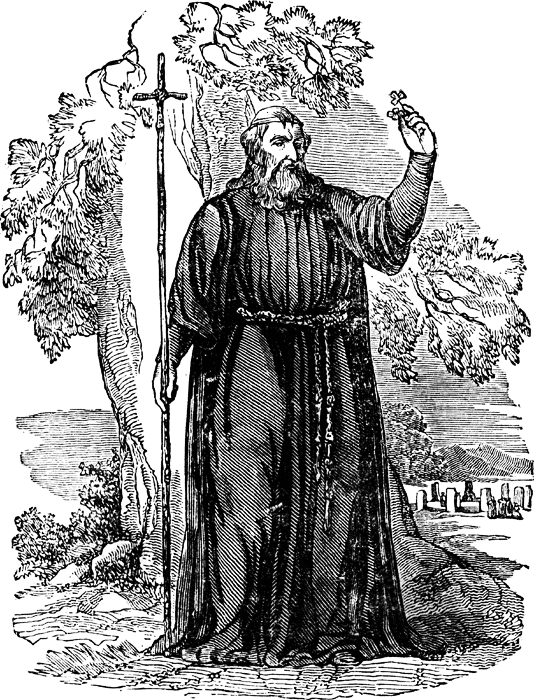St. Patrick's Stones
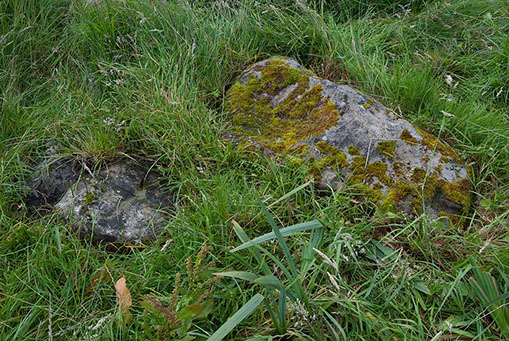
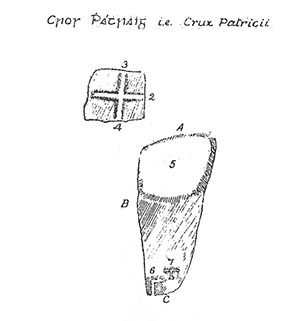
A short distance south of the ruins of Crosspatrick, outside the boundary of the cemetery, in a nearby field, (cross over the parallel road and access behind the adjacent house) some curious stones may be viewed.
Inscribed with markings reputedly made by Saint Patrick, including as they are colloquially referred to ‘St Patrick’s Seat,’ ‘St. Patrick’s Pipe’ (Crozier) and a stone bearing a cruciform detail known as ‘St. Patrick’s Cross,’-it is from these stones and this one in particular that Crosspatrick gets its name. The Revue Celtique maintains that several of the early Christian saints, including Patrick, cut crosses and the words “Jesus” or “Soter” on stones and pillars.
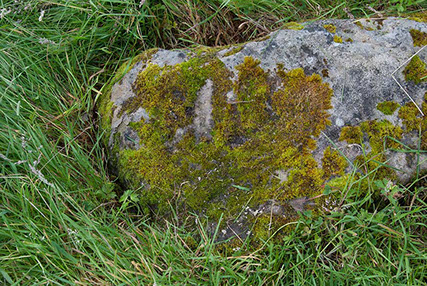
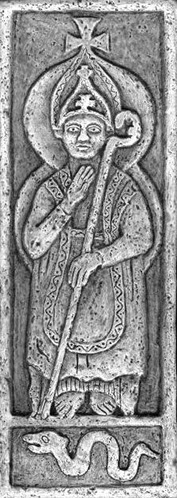 In the accompanying sketch of the stones which dates from 1838, a small Tau cross is also visible-unfortunately it is no longer discernible. As the Druids or “adders” (after the snake) of old were known to carve the Tau cross into trees and stones, and as St. Patrick is famed for having cast out all the serpents from Ireland, many hold the belief that this Tau cross has a more esoteric meaning and may have been formed from a curling serpent.
In the accompanying sketch of the stones which dates from 1838, a small Tau cross is also visible-unfortunately it is no longer discernible. As the Druids or “adders” (after the snake) of old were known to carve the Tau cross into trees and stones, and as St. Patrick is famed for having cast out all the serpents from Ireland, many hold the belief that this Tau cross has a more esoteric meaning and may have been formed from a curling serpent.
Linked with Thoth who is referenced as being the originator of serpent worship in Phoenica and the inventor of hieroglyphs, the letter or Tau symbol is also thought to be the “Mark of Cain,” who was known as the “son of serpents.” It is further believed that the forms and movements of serpents were employed in the invention of the oldest letters, which represent gods-hence the Greek Tau, which is where the name Tau cross comes from-a simple T.
In more modern times the Tau gained other meanings and some historians claim that it may be a symbol for the Templus Hierosolyma or the Temple of Jerusalem, while others hold that it signifies hidden treasure or means Clavis ad Thesaurum, “A key to treasure” or alternatively, Theca ubi res pretiosa, “A place where the precious thing is concealed.” It was also the symbol for St. Anthony who lived in the 4th century AD -later to become the symbol for the Knights Templar of St. Anthony of Leith in Scotland. St. Anthony is credited with establishing Monasticism in Egypt.
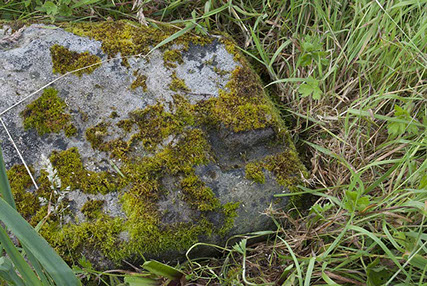 The serpent is the Divine Wisdom of several lands, and the serpent was certainly the token or symbol of an ancient race celebrated for wisdom, giving rise to the naming of the learned after dragons or serpents. Many hold the belief that the ‘Snake Race’ were primeval seafarers and that the faring-wise serpent race became at the earliest stage of tradition rulers and civilizers, in fact The Druid of the Welsh Triads exclaimed, “I am a serpent.”
The serpent is the Divine Wisdom of several lands, and the serpent was certainly the token or symbol of an ancient race celebrated for wisdom, giving rise to the naming of the learned after dragons or serpents. Many hold the belief that the ‘Snake Race’ were primeval seafarers and that the faring-wise serpent race became at the earliest stage of tradition rulers and civilizers, in fact The Druid of the Welsh Triads exclaimed, “I am a serpent.”
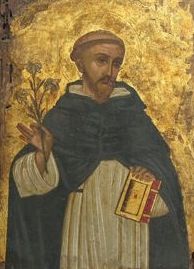 In relation to St. Patrick banishing the snakes or serpents from Ireland many associate this with the expelling from the converts of the old Serpent, the Devil. As the nineteenth-century scholar Professor O’Neill, observed—“The conquest which the Irish Apostle of Christianity is said to have gained over the serpents of Ireland has been doubted, but if it means that he gained a victory over the serpent-worship, the story seems entitled to credit.”
In relation to St. Patrick banishing the snakes or serpents from Ireland many associate this with the expelling from the converts of the old Serpent, the Devil. As the nineteenth-century scholar Professor O’Neill, observed—“The conquest which the Irish Apostle of Christianity is said to have gained over the serpents of Ireland has been doubted, but if it means that he gained a victory over the serpent-worship, the story seems entitled to credit.”
“Search where we will,” says Kennersley Lewis, “the nuptial tree, round which coils the serpent, is connected with time and with life as a necessary condition; and with knowledge—the knowledge of a scientific priesthood, inheriting records and traditions hoary, perhaps, with the snows of a glacial epoch.”
Killala.
May 30th, 1838.
Sir,
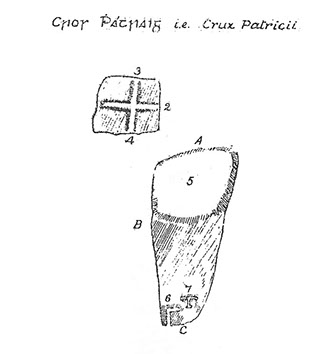 I came here yesterday from Ballina, and examined the locality of the old Church of Crosspatrick which stands in ruins immediately to the east of the road leading from Ballina to Killala, and within a short mile of the latter.
I came here yesterday from Ballina, and examined the locality of the old Church of Crosspatrick which stands in ruins immediately to the east of the road leading from Ballina to Killala, and within a short mile of the latter.
Within twenty perches of the old church (of Cross Patrick) to the south, I found a stone measuring about fourteen inches by twelve, and six inches thick on one side, and four on the other. On this stone there is a cross inscribed, the two lines composing which are each about nine inches in length, and very little more than one inch in breadth. They are not deeply cut, being sunk not more than a quarter of an inch. At this lies a flagstone about three feet long, which at the smaller end is about one foot broad, and gradually increasing is about eighteen inches at the middle, and still continuing to increase, is twenty inches at the broader end, which lies next to the cross. On the broader part there is a cavity, not deeply sunk, but taking up very nearly the whole breadth and more than a foot in length, where, tradition says, Saint Patrick sat. There is an incision about three inches long and one inch broad and nearly half an inch deep representing, though perhaps imperfectly, the form of the upper part of the crozier. The part of the incision which turning (curved) forms the appearance of the crook, is one inch long, at the very point of which is cut in fine (small) but distinctly visible lines the form of T, each line of which is one inch in length. The former of these incisions is said to be the mark of Saint Patrick’s Pipe, and the latter is not in general described, as it, though evidently artificial, may be passed unobserved by most persons, excepting the curious, or those who go to examine the marks on the stone. There are some however, who supposed it to be the impression of a small cross such as is attached to a beads. Both these stones lie horizontally, and the thickness of the flag stone, which lies a little sunk in the earth growing about it, cannot on that account be well ascertained. At the broader end where it is not covered it does not exceed six inches in thickness...”
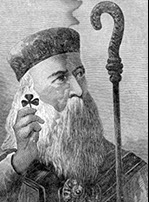 Both local tradition and ecclesiastical writings attribute several miracles to St. Patrick, many of which were performed close by this place; miracles such as restoring sight to the blind, restoring the use of crippled limbs, and bestowing life on a deceased woman and her unborn child.
Both local tradition and ecclesiastical writings attribute several miracles to St. Patrick, many of which were performed close by this place; miracles such as restoring sight to the blind, restoring the use of crippled limbs, and bestowing life on a deceased woman and her unborn child.
It is also told that at nearby Forrach-mhae-nAmhalgaidh, present day ‘Mullafarry’- ‘The Hill of the Meeting Place’-‘The Meeting Place of the Sons of King Awley,’ Patrick baptized 12,000 converts into the Christian faith, including the aforementioned sons of King Awley . It is further recounted that Patrick then caused a square church of earth to be constructed on the site. Mullafarry is the birth place of the labour activist, nationalist patriot, and social reformer, Dr. Kathleen Lynn.
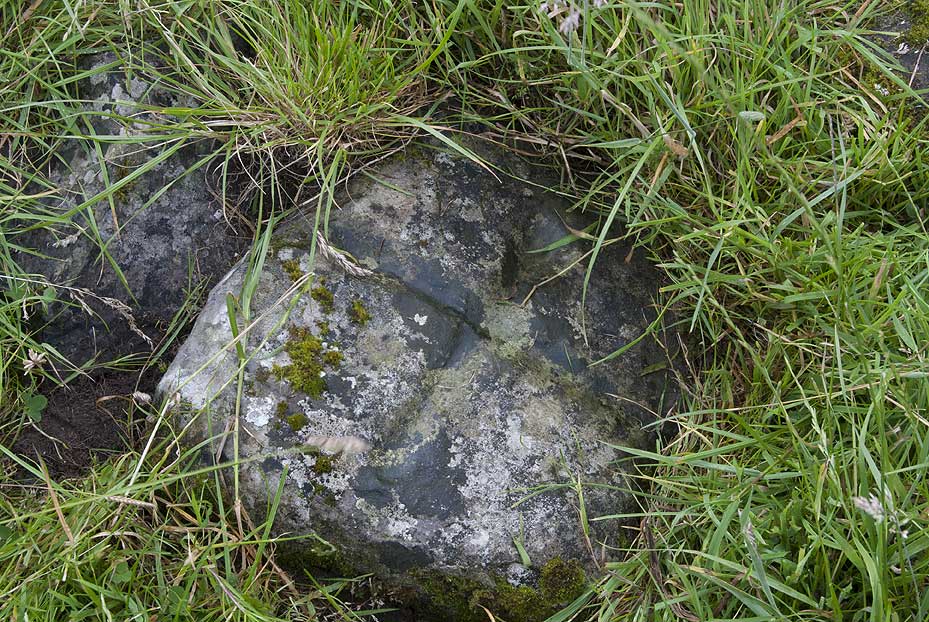
View these photos in a gallery







